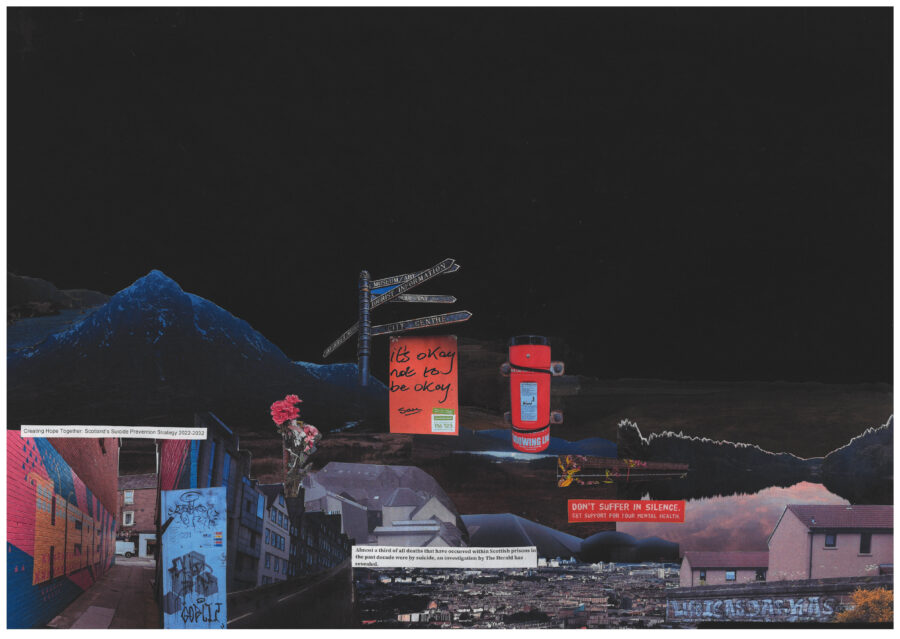Here at the Suicide Cultures project we have reached an exciting phase of our research. After a year and a half of data collection involving interviews and ethnographic engagement with people affected by suicide, we are beginning to transition to data analysis. This means we are working to pick out patterns or themes from the stories we have gathered, with the hope of understanding how people understand and experience suicide across our three sites in Scotland. As well as conversations, our research has involved attending mental health and suicide related events, arts-based activities with participants, and analysis of institutional and multi-agency reports on suicides within the Scottish Prison Service and the NHS. In this blog we share a brief summary of how our fieldwork unfolded, reflecting on some of the lessons we have learned while doing qualitative research on suicide.
What Did We Do?
Over the last year and a half, we conducted 58 in-depth qualitative interviews with people who have been affected by suicide. This includes 28 interviews with people bereaved by suicide, 18 with people who have attempted suicide, and 27 from people who work in suicide prevention1. We also spoke with many more people during ethnographic work with 12 mental health and suicide prevention community organisations who have kindly opened their events and offered their time to us. Our three larger sites represent a diverse picture of ways of life in Scotland, including rural, suburban, urban, and island communities, different levels of economic affluence and disadvantage, as well as a range of ages from 18 – 80. Interestingly, our data tends to skew towards older demographics of people.
These qualitative methods have provided an unprecedented window into the individual, social and cultural contexts that underlie the issue of suicide in Scotland. Using different methods has meant we could talk to people who either can’t or don’t want to sit down for a formal interview. For people with severe mental health issues or for those who have experienced abuse at the hands of people they trusted (whether a loved one, stranger, medical provider, or service) there may be good reasons to want to avoid doing a recorded interview. Less formal conversations during our extended fieldwork have allowed us to explore how distress can be caused by issues like poverty, the cost-of-living crisis, state institutions (like schools, prisons, hospitals), families, discrimination, as well as other cultural factors.
Insights and Limitations
One of the major limiting factors across all three of our sites was that community groups and third sector organisations are operating within a funding landscape defined by scarcity of resources. We did a spend a lot of time with 12 organisations, including several who are under-resourced. However, we sometimes found that groups were unable to engage with us because staff members did not have the time to include us at events and/or facilitate conversations with service users, simply because they were so thinly stretched themselves. One CEO of a suicide prevention charity was officially a part time employee yet told us that she worked over 60 hours a week just to keep the organisation running effectively for their members. These groups provide a vital service to the community in the absence of adequate statutory care, yet short term limits and competition for funding means that they have to be flexible and many struggle to keep staff for longer periods of time. This absence of consistent funding is to the detriment of the many people these organisations support as well as to the staff who work so hard to maintain them.
Secondly, there has been some difficulty with engaging groups who have a more general focus on mental illness or disability rather than specifically suicide. Our interviews have given us ample space to think through suicide with our participants, but there hasn’t always been space to ask explicit questions about it in our ethnographic research within community organisations. Some groups suggested that mentioning suicide at their events may have a damaging effect on service users, reflecting widespread beliefs (often framed as ‘myths’ in suicide prevention literature) that talking about suicide might cause suicide. At the same time, fears of ‘contagion’ – that the very idea of suicide can be dangerous, are also prominent. These issues are especially challenging for us as “suicide researchers” attempting to work in and with a range of community groups. While, some literature does suggest that talking about suicide is ‘safe’, we recognised that the focus of our work – our identity as ‘suicide researchers’ – may have brought the wrong atmosphere to groups that are about living well despite distress.
The Emotions of Suicide Research
In any project that uses ethnography and qualitative interviewing the researcher is brought into intimate contact with their participants. This is particularly the case for people researching suicide. We have been sitting alongside people as they talk us through some of the more difficult emotional experiences it is possible to have. Each of us has felt an immense privilege in being witness to these stories, and we have received feedback that we have been able to offer people a non-judgmental space to explore their experiences. Unlike many of the services they engage with, we did not require that our participants aim to recover or get better, nor did we demand that they begin courses of medication or change their habits. The simple act of gently inquiring without judgment has given people a unique space to think through their experiences.
Yet, we also have to acknowledge that this work has at times been difficult for us. Each of the research fellows on the project have needed to process challenging emotions while attending to other people’s stories about suicide. Empathising with and feeling others’ emotions can be powerfully positive for ourselves, for the people we spoke with, as well as for producing rich qualitative data, yet whenever we engaged in fieldwork or an interview, we learned to be aware that we may come away with an imprint of those emotions.
So, how have we attempted to stay as healthy and stable as possible while researching suicide? We have held monthly peer support sessions within our team dedicated to expressing and exploring the challenges that have been arising in the course of our research. Throughout our work we have also developed relationships within the team that allow more informal and frequent check-ins and debriefs after particularly challenging moments. While creating more spaces to talk has been useful, often what we needed was time away from the topic of suicide all-together. In the hours after an interview or piece of ethnographic work we found it important to create space for rest and time to engage in hobbies or activities that bring us joy.
Our Plans for Analysis
As we move into our analysis phase, we are meeting weekly to discuss specific pieces of data. Using a combined approach of abductive, thematic, and narrative analysis we will be processing this data over the next six months or so. As themes emerge from this analysis, we will also start planning publications and other outputs to share our findings. This is an exciting phase, and we invite you to keep an eye on our blog, podcast, and newsletter to stay up to date about when we will be releasing this information.



